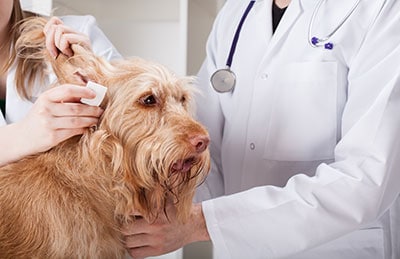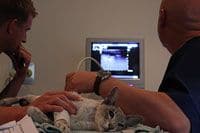How To Give Ear Medication To Your Dog Properly
The facts about ear medication for dogs

Ear infections are popular, especially in warm climates such as those we experience in Australia. It’s important you understand your dog’s ears. It is also very important you complete the dose of prescribed medication provided by your veterinarian in the event your pet is diagnosed with an ear infection.
Symptoms of an ear infection
- Scratching and rubbing at the ears or jaw
- Shaking their head
- An unusual odour from the ears
- Redness or swelling in the ears
How to apply ear medication
- Prior to applying medication to your dog’s ears, give them a treat and let them sniff the bottle so they are not afraid of the object.
- Gently hold the ear upright and press the fluid as far into the ear as you can manage without causing pain. The tube must always remain vertical so the contents are easily dispensed.
- Keep hold of the ear and move your other hand down the ear canal until you meet their jawline. Your dog’s ear canal is deep and extends in an L shape.
- Massage until you hear a “squishy noise”. The squishy noise means you are on track and doing it right.
- Massage for at least 20 seconds.
If done correctly, your dog will shake their head once you stop. Grab some cotton wool and wipe down their outer ear without entering the ear canal.
If you don’t hear the “squishiness” – repeat. If you don’t hear it upon the second attempt and your pet is uncomfortable, make an appointment with your veterinarian.
Maintenance of your pet’s ears
Clean frequently with a gentle cleanser your veterinarian recommends. Fill your pet’s ear canal with the cleaning solution and follow the steps outlined above.
Wipe the canal opening with cotton wool while you massage the base of your dog’s ear canal. Their ear canal runs deeply so rubbing the base allows the fluid to go back and forth dislodging foreign objects and bacteria. The cotton wool absorbs the excess solution and debris.
DO NOT use ear buds or Q-tips. You may push the debris deeper or rupture the eardrum.
DO NOT use rubbing alcohol or other solutions containing alcohol as this will irritate or inflame the skin in the ear canal.
DO NOT use olive oil, vinegar, shampoo or any other substance as these will cause irritation and further damage.
What to expect at the vet
Most ear infections are the result of bacteria, yeast or ear mites. Your veterinarian will take a sample from the infected ears to examine under a microscope. This will help them identify what the microorganisms are so they can recommend the appropriate medication for treatment.
Prevention
Prevention depends on the underlying cause of the ear infection. In some cases, the ear becomes moist from bathing, grooming or swimming and this moisture promotes the growth of bacteria. Frequent cleaning is required in these instances via a regular flush-and-wipe routine to prevent build-up of moisture and subsequent bacteria.
Some pups suffer allergies from the environment, pollens, mites, or food and are predisposed to ear infections. In these instances, your veterinarian will dispense medical ear drops to help prevent future inflammation.
Routine cleaning of your pet’s ears is highly recommended to prevent infection. If you’re not sure what product to use, or how to do this appropriately, we suggest making an appointment with your pet’s General Practitioner for advice about the best product for your pet as well as instruction about how to adequately maintain your pet’s ears.
Other Important Information
If you clean your dog’s ears regularly they will come to enjoy it after time. It’s like a human massage and they enjoy the time they spend with you as well as the attention. If you find you pet is not comfortable, they’re in pain, there is an unusual odour, or you don’t achieve the “squishy noise” – we recommended you seek veterinary help as your pup may need prescribed ear drops to help them be more comfortable.



